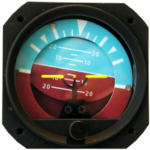The easiest way is to call Air Traffic Control and follow their instructions as they talk you down. That’s what the passenger in the video below did after the pilot passed out.
Otherwise, don’t panic. Here are the basics. First, understand the controls.
Pushing forward on the control column makes the nose go down. Pulling back on it makes it go up. Gentle and easy, not too much.
The foot pedals operate the rudder. Turning the wheel (or pushing the stick) side-to-side operates the wing ailerons. You use both to turn the plane. Gently push on the foot pedal and turn the wheel in the direction you want to go (e.g., push left, turn wheel left, to go left). The idea is to bank the plane as you turn.
Use the throttle to control climb or descent. Adding power makes the plane climb; reducing power makes it descend.
Note: A plane will lose some lift while banking in a turn, so you may need to add a little power when turning to keep it level. Also, don’t try to climb by just pulling back on the control column, because this can cause a “stall” (i.e., the wings lose lift), which will cause the plane to violently pitch downward. If this happens, push the control column forward and add power; the plane should then level itself.
 If you can’t see the horizon because of cloud, smoke, or haze, use the artificial horizon (photo). It tells you whether the plane is flying level, climbing, or descending, and whether it’s banking or flying straight. Trust the instrument, not your gut or the seat of your pants. (In the photo, the plane is banking right and climbing.)
If you can’t see the horizon because of cloud, smoke, or haze, use the artificial horizon (photo). It tells you whether the plane is flying level, climbing, or descending, and whether it’s banking or flying straight. Trust the instrument, not your gut or the seat of your pants. (In the photo, the plane is banking right and climbing.)
The altimeter (when properly calibrated) tells you how far above sea level, not the ground, you’re flying. If the runway is 1,000 feet above sea level, and the altimeter says 994 feet and the airspeed indicator reads 0, you’re in a 6-foot-deep crater at the end of the runway.
When landing, visually line up with the runway, and slowly descend, but don’t come in too high or you’ll overshoot the runway. If you’re too high, abort the landing and go around to make the approach again.
Coming in, keep the wings level, and lower the flaps on final approach (on single-engine planes, there may be a flap lever between the seats). This increases lift and gives you a lower landing speed and shorter stopping distance. When you’re just above the runway, reduce power and pull back on the control column to “flare.” This raises the nose to dump lift from the wings. Do it right and you’ll gently set down; do it wrong and you’ll bounce.
Once on the runway, you want the plane to roll straight until it stops. Use the foot pedals, not the wheel, to steer. The brakes are operated by pushing down (toeing) the front ends of both pedals at the same time. If you skid off the runway or crash, get out of the plane and as far away from it as quickly as you can, in case it catches fire.
This article is for entertainment only, and no representation or warranty is made as to the accuracy or efficacy of these instructions. You won’t be reading them anyway while trying to cope with a heart-stopping in-flight emergency.